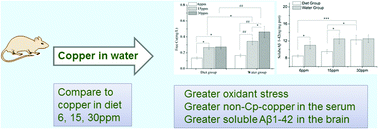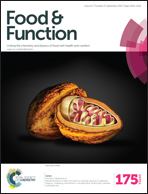The effect of copper from water and food: changes of serum nonceruloplasmin copper and brain's amyloid-beta in mice†
Abstract
Copper is an essential element and also produces adverse health consequences when overloaded. Food and water are the main sources of copper intake, however few studies have been conducted to investigate the difference between the ways of its intake in water and food in animals. In this study, copper was fed to mice with food as well as water (two groups: water and diet) for three months at concentrations of 6, 15 and 30 ppm. The copper concentration in water was adjusted for keeping the same amount during its intake in food. The experimental studies show a slow growth rate, lower hepatic reduced glutathione (GSH)/superoxide dismutase (SOD) activity and higher serum ‘free’ copper in the water group. The brain's soluble amyloid-beta 1-42 (Aβ42) of the water group was significantly higher than that of the diet group at the levels of 6 and 15 ppm. In conclusion, copper in the water group significantly increased the soluble Aβ42 in the brain and the ‘free’ copper in the serum, decreased the growth rate and hepatic GSH/SOD activity. The research studies carried out suggest that the copper in water is more ‘toxic’ than copper in diet and may increase the risk of Alzheimer's disease (AD).


 Please wait while we load your content...
Please wait while we load your content...